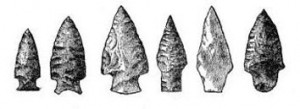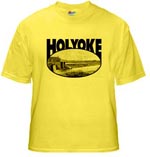by Laurel | April 1st, 2014
01 April 1928
Section Was Heart of Indian Country — Tribe Feuds Recalled
Artistry in Pottery Discoveries Studied
Iroquois Originated Color Ornamentation — Sources of Clay Deposits Traced
— Suggestions for Searchers.
A great number of Holyoke people fail to realize that this section is located in the heart of the Indian country and that with a little pains and observation it is possible for almost anyone to acquire relics of one kind or another of the tribes that have long since gone to the happy hunting grounds.
Many men in the valley have for years made a study of these things; locally the best posted man is undoubtedly Architect W. J. Howes, into whose charge recently Christian F. Schuster gave 150 or so fragments of Algonquin and Iroquois pottery that are later to be placed in the natural history museum at the public library. Architect Howes was asked a few days ago about how a novice in the art of picking up Indian relics would go about it. Most of such relics said Mr. Howes are to be found in or near the site of the Indian encampments. Of course a stray arrowhead may be found in about any field.
It was the custom of the Indians when they encamped to get from the river bed flat pieces of shale for use in building their camp fires. The fire reddened these pieces of shale so that one of the first indications of the locating of an encampment or lodge site would be the presence of these reddened stones.. These are found in a freshly plowed field or in a field where corn or potatoes have been pulled up. Having determined by the presence of such stones that an encampment site has been found, articles that would not ordinarily be recognized as used by the Indians should be looked for.
Pottery Discoveries Important
One should keep a sharp eye out for broken pieces of pottery. Crescent shapes bits of stone that have been chipped need to be observed carefully; such bits that show finer chipping in the center of the curve indicate that they have been sharpened for use in shaving or smoothing arrow shafts. Other bits of stone that had been sharpened at one end have been used for other purposes, as a stone ac or chisel or celt or arrowhead. But tot he practical seeker for Indian relics the arrowhead is in about the position that a Bartlett pear is to a group of professional pomologists. It is the pottery that is the most interesting and important.The tribes in this section were Algonquins; those further west the Iroquois. The Mohawks were the ones that made trouble here and to which the Algonquins paid tribute rather than suffer from their predatory raids. There is quite a long story in connection with this of which it is necessary here to give only the general outlines. A terrible scourge, some think the yellow fever, swept over the Algonquin country along about 1600; and a year or two before the Mayflower brought a second scourge, smallpox. These diseases so reduced the Algonquins, that when the settlers came, the Indians were weak in numbers. It was because of the great scourge of the early 1600’s that the Mohawks got their front-hold and made the weakened Algonquins subservient.
How Clay Was Obtained
The clay for the pottery of the Algonquins was obtained across the river where the rain had washed gullies down in the clay banks. Here the Algonquin squaws, when the tribes came out of their winter quarters for the fishing and hunting season, busied themselves with fashioning the clay into pots and kettles and pans” as the rhyme goes, at any rate, into pots of varying sizes. The art of decorating by the Algonquins was very crude and it remained for the Iroquois to improve it. They not only ornamented the edges of pots, but superimposed upon its body an ornamental hand. In one valuable piece in this Schuser collection, the Iroquois pottery artist had gone still further; not only adding the ornamental strip, but taking some of the graphite used in the inside of the pot and staining the upper edge of this hand black. This was the first stage in ornamenting in color anywhere in the country. How the Iroquois pottery got here is explained as probably due to the tribe coming here and taking away with them clay for their pots. Sometimes a pot would call and break, sometimes it would be unsatisfactory, and sometimes for other reasons it would be left; hence the broken bits of Iroquois pots, though but small as compared with the ruder fragments of Algonquin make.
Adapted from The Springfield Republican.









